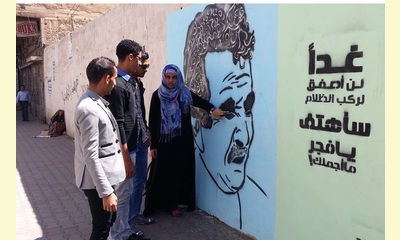|
|
Yemen's youth draw peace messages in Sanaa streets
un articulo por Faisal Darem, Al Shorfa (abridged)
In a six-month campaign titled "Open Book",
Yemeni youth drew on the walls of streets across
the country to promote peace and denounce
violence. 
Tamam al-Shaibani, Muhammad al-Sharie, Yasser al-Mujahid and Atheer al-Mujahid stand near a message and picture of Yemen's most famous poet, Abdullah al-Baradouni. [Faisal Darem/Al-Shorfa]
click on photo to enlarge
Campaign participants aimed to encourage
Yemenis to ascribe to a culture of amity, peace
and co-existence while rejecting a culture of
death, extremism and hatred, organisers told Al-
Shorfa.
"The culture of killing, weapons, violence and
death has proliferated dramatically in the capital
Sanaa and other provinces, to such an extent that
slogans of death have reached the walls of
Sanaa," campaign founder Tamam al-Shaibani
told Al-Shorfa.
"Thus the genesis of the 'Open Book' to counter
the culture of violence and extremism by painting
on walls and selecting phrases and quotes of
thinkers, writers and famous global figures which
appeal to people of all orientations," he said.
"We saw slogans inciting killing, violence and
hatred splashed across street walls, so we were
determined to counter them with a culture of art
and life," he added.
"The walls have become an important platform for
appealing for peace and a means to convey our
ideas, as these ideas have become the focus of
everyone's attention," al-Shaibani said.
Campaign organisers chose "Open Book" as their
central idea as it seemed to them Yemenis had
abandoned reading and become preoccupied with
the country's on-going conflicts among political
factions or armed groups, he said.
So, al-Shaibani said, they decided to "bring the
book to the street, in which each page contains a
number of phrases which speak to the mind of the
reader and compel him to think about them, to
entice him to return to the pen, booklet and book
instead of the Kalashnikov".
The campaign met with positive reactions and
praise from the vast majority of Yemenis, he said.
In addition, interaction with the youth segment
was at its highest, as organisers spread invitations
announcing the project across social media
networks.
Sanaa University student Mohammed al-Sharie,
who helped al-Shaibani launch the campaign, said
"Open Book" selected some of the most famous
quotes by freedom fighters, writers and politicians
to paint on walls across the country.
The campaign began April 23th in Sanaa and
continued for around five months, then moved to
Taiz in the last week of October to disseminate
phrases of peace and life in place of a culture of
violence and conflict, he said.
"We chose the province of Taiz as it is the capital
of Yemeni culture" and because it has been
targeted by armed groups and sectarian conflicts,
al-Sharie said.
Atheer al-Mujahid, the sole female activist on the
campaign, said she faced various difficulties as
the initiative progressed, starting with her family
as she was "the only girl in a group of men in a
conservative society".
Al-Mujahid said her family eventually recognised
that what she and her friends were doing was
"extraordinary and deserves praise and support". .
.
(Thank you to the Global Campaign for Peace
Education for calling this article to our attention.)
|








|
DISCUSSION
Pregunta(s) relacionada(s) al artículo :
Can popular art help us in the quest for truth and justice?,
* * * * *
Comentario más reciente:
CPNN has received the following message from Marcel in Africa:
My name is Marcel Niyungi Bin Yungi, I am an artist peacemaker based in Nairobi, in Kenya. I use comics to promote a culture of peace. Some of my works can be found online at www.peace.ca/marcelscomicstrips.htm. Currently, I am publishing a bimonthly comic series for young people entitled "The Adventures of Kialu for Peace" (please find below a brief summary and attached an advert).
I am writing to inquire about CPNN and would like to be part of it.
I thank you in advance for your cooperation and look forward to hearing from you.
ABOUT THE ADVENTURES OF KIALU FOR PEACE
1.INTRODUCTION
When we listen to the news, read the newspapers... a day doesn't pass without violence or a threat of violence. Our daily life is full of fear of harm; violencwe has escalated, it is everywhere: at home, at work places, at schools, on the streets,etc in every continent.
The solution to bring about and maintain a peaceful world lies in our hands, in our willingness and commitment to do what is good and peaceful to ourselves, to others and to the environment.
The Adventures of Kialu for Peace are a non-commercial, apolitical bi-monthly comic series, published by Jipa Moyo COMICS (jipa moyo is Kiswahili for take courage),whose objective is to promote a culture of peace.
2.TARGET GROUP: Young people.
3.THE COMIC SERIES
The Adventures of Kialu for peace are an ongoing serial publication. Each series focuses on a particular form of violence, abuse, depravity, anti-social behavior, environmental deterioration,etc. They are not only educational but also entertaining.
4.KIALU, THE HEROINE
4.1.WHO IS SHE?
Kialu is a brave girl from a small village in Africa who is serving humanity through her good deeds by the help of three powers contained in a magic stick that she acquired from an old woman.
4.2.WHY THE NAME OF KIALU?
The name "Kialu" has its origin from Bambole Kingdom, one of the vast Kingdoms in history of Africa. . ... continuación.

|
|









